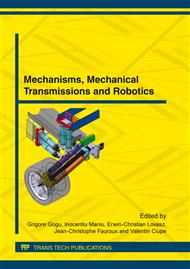[1]
S. Brose, D. Weber, B. Salatin, G. Grindle, H. Wang, J. Vazquez, R. Cooper, The Role of Assistive Robotics in the Lives of Persons with Disability, Physical Medicine and Rehabilitation. 89(6), (2010) 509-521.
DOI: 10.1097/phm.0b013e3181cf569b
Google Scholar
[2]
N. Roy, G. Baltus, D. Fox, F. Gemperle, J. Goetz, T. Hirsch, D. Margaritis, M. Montemerlo, J. Pineau, J. Schulte, S. Thrun, Towards Personal Service Robots for the Elderly, Workshop on Interactive Robotics and Entertainment. (2000).
Google Scholar
[3]
J. Nehmer, M. Becker, A. Karshmer, R. Lamm, Living Assistance Systems: An Ambient Intelligence Approach, Proc. of the 28th International Conference on Software Engineering. (2006) 43-50.
DOI: 10.1145/1134285.1134293
Google Scholar
[4]
W.S. Wijesoma K.S. Wee, O.C. Wee, A.P. Balasuriya, K.T. San, L.K. Soon, EOG Based Control of Mobile Assistive Platform for the Severely Disabled, Proc. 2005 IEEE Int. Conf. on Robotics and Biomimetics (ROBIO 2005). (2005) 490–494.
DOI: 10.1109/robio.2005.246316
Google Scholar
[5]
M. Duguleana, G. Mogan, Using Eye Blinking for EOG-Based Robot Control, IFIP Advances in Information and Communication Technology: Emerging Trends in Technological Innovation. 314 (2010) 343-350.
DOI: 10.1007/978-3-642-11628-5_37
Google Scholar
[6]
C. -C. Postelnicu, F. Girbacia, M. Duguleana, D. Talaba, EOG-based Teleoperation of a Mobile Robot, Proceedings of the 3rd International Conference on Future Computer and Communication, 6pp.
Google Scholar
[7]
R. Barea, L. Boquete, M. Mazo, E. Lopez, System for Assisted Mobility Using Eye Movements Based on Electrooculography, IEEE Trans. Neural Systems and Rehabilitation Engineering. 10(4) (2002) 209–218.
DOI: 10.1109/tnsre.2002.806829
Google Scholar
[8]
Guger Technologies, http: /gtec. at.
Google Scholar
[9]
M. Montermerlo, J. Pineau, N. Roy, S. Thrun, V. Verma, Experiences with a Mobile Robotic Guide for the Elderly, AAAI National Conference on Artificial Intelligence. (2002).
Google Scholar
[10]
M. Pollack, L. Brown, D. Colbry, C. Orosz, B. Peintner, S. Ramakrishnan, S. Engberg, J. Matthews, J. Dunbar-Jacob, C. McCarthy, S. Thrun, M. Montemerlo, J. Pineau, N. Roy, Pearl: A Mobile Robotic Assistant for the Elderly, AAAI Workshop on Automation as Caregiver. (2002).
Google Scholar
[11]
G. Lacey, K. Dawson-Howe, The Application of Robotics to a Mobility Aid for the Elderly Blind, Robotics and Autonomous Systems. 3(4), (1998) 45-252.
DOI: 10.1016/s0921-8890(98)00011-6
Google Scholar
[12]
C. -C. Postelnicu, D. Talaba, M. -I., Toma, Controlling a Robotic Arm by Brainwaves and Eye Movement, IFIP Advances in Information and Communication Technology: Technological Innovation for Sustainability. 349 (2011) 157-164.
DOI: 10.1007/978-3-642-19170-1_17
Google Scholar
[13]
V. Kulyukin, C. Gharpure, J. Nicholson, G. Osborne, Robot-assisted Wayfinding for the Visually Impaired in Structured Indoor Environments, Autonomous Robots. 21(1), (2006) 29-41.
DOI: 10.1007/s10514-006-7223-8
Google Scholar
[14]
R. Barea, L. Boquete, M. Mazo, E. Lopez, Wheelchair Guidance Strategies Using EOG, Intelligent and Robotics Systems. 34 (2002) 279-299.
Google Scholar
[15]
M. Brown, M. Marmor, Vaegan, E. Zrenner, M. Brigell, M. Bach, ISCEV Standard for Clinical Electro-oculography (EOG), Documenta Ophthalmologica. 113(3) (2006) 205-212.
DOI: 10.1007/s10633-006-9030-0
Google Scholar


